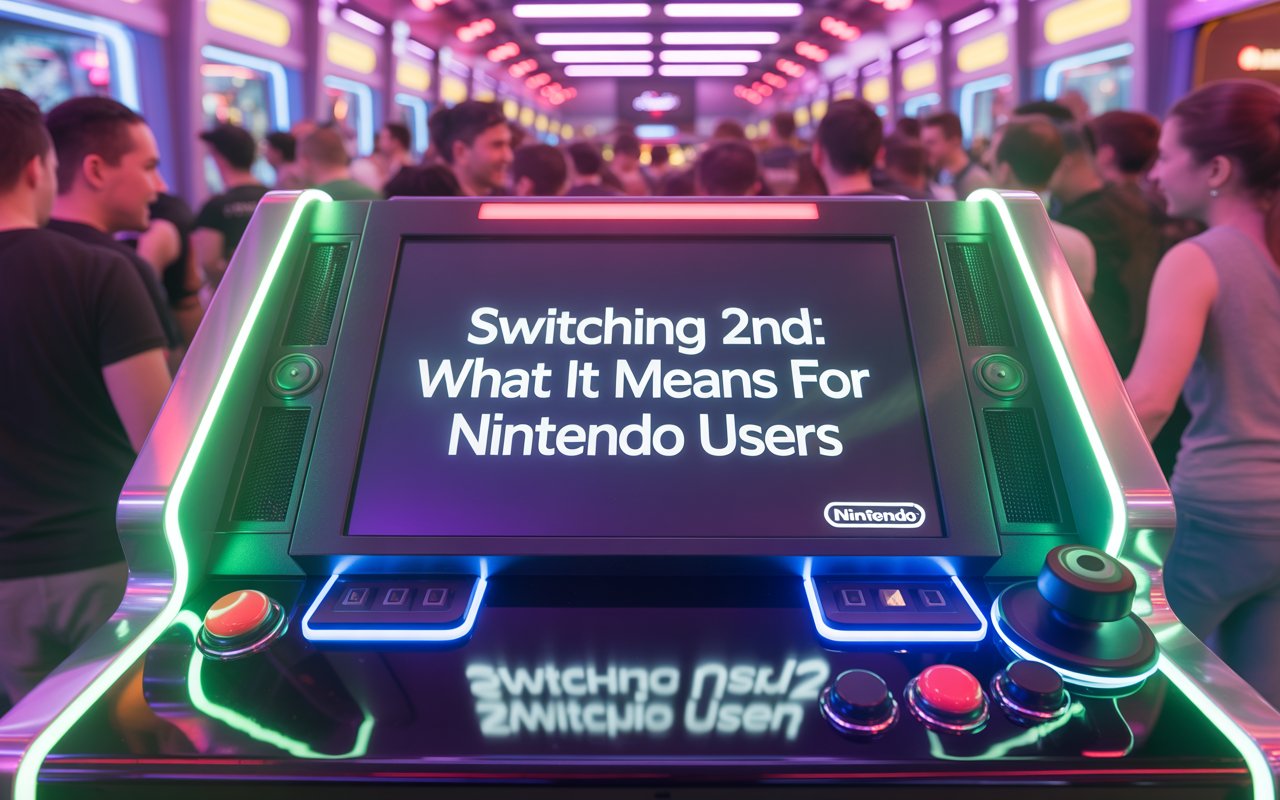In the gaming community, new terms emerge all the time, and lately, “Switching 2nd” has been making the rounds among Nintendo fans. While it might sound like a racing move or a tactical sports play, in the world of Nintendo, it refers to moving from your first Nintendo Switch console to the next-generation model—whether that’s the Nintendo Switch OLED or the much-rumored Nintendo Switch 2.
This trend isn’t just about having the latest gadget—it’s about staying competitive, experiencing better graphics, enjoying faster load times, and getting access to exclusive titles. But is it worth making the jump? Let’s explore what “Switching 2nd” really means, why it’s trending, and whether now is the right time for you to make the switch.
Introduction – Understanding the “Switching 2nd” Buzz
The phrase “Switching 2nd” has popped up in gaming forums, YouTube reviews, and social media discussions. It’s essentially gamer slang for upgrading from your current Nintendo Switch to a newer version. This could mean:
-
Moving from the original Nintendo Switch to the Switch OLED
-
Upgrading in anticipation of the Nintendo Switch 2 (often called “Switch Pro” in rumors)
Nintendo fans have always been passionate about their hardware, and with new games demanding better performance, it’s no surprise that many are considering this upgrade. The buzz isn’t just hype—it’s fueled by leaks, Nintendo’s hardware release patterns, and the promise of major technical leaps.
What Does “Switching 2nd” Mean in the Nintendo World?
The Origin of the Term
The term likely originated as shorthand in online discussions. Gamers talking about upgrading often wrote “switching to 2nd gen,” which gradually got shortened to “Switching 2nd.” It became a catchphrase for anyone making the leap to the next console generation.
Why It’s Gaining Attention Now
There are two big reasons:
-
Nintendo’s console life cycle – Historically, Nintendo refreshes its consoles every 6–7 years, and the original Switch launched in 2017. This means a successor is expected soon.
-
Performance demands – Popular games like The Legend of Zelda: Tears of the Kingdom push the original Switch to its limits, leading many to crave faster performance.
The Nintendo Switch Generational Evolution
From Nintendo Switch to Switch OLED
The Nintendo Switch OLED, released in 2021, introduced a vibrant 7-inch OLED screen, improved speakers, and a sturdier kickstand. While it didn’t increase processing power, it delivered a noticeably better handheld gaming experience.
Rumors of the “Switch 2” and What to Expect
Industry insiders have hinted that the Switch 2 could feature:
-
4K output when docked
-
Faster processors and more RAM
-
Backward compatibility for existing Switch games
-
New Joy-Con technology with improved durability
If these rumors hold true, “Switching 2nd” might not just be a small upgrade—it could be a leap forward for Nintendo gaming.
Reasons Nintendo Users Consider Switching 2nd
Hardware Upgrades
Newer consoles generally mean better screens, faster processors, and more storage. For gamers who play graphics-intensive titles, these improvements can make a world of difference.
New Game Releases
Some upcoming Nintendo titles might be optimized for newer hardware, offering better frame rates and visual fidelity on the Switch 2. Missing out on these enhancements could be a dealbreaker for competitive players.
Improved Online Experience
With each new hardware release, Nintendo tends to enhance its online services—better matchmaking, faster downloads, and improved voice chat features are all possibilities.
Pros and Cons of Switching to the 2nd Generation Console
Key Advantages
Upgrading to the next-generation Nintendo console brings several benefits:
-
Enhanced Visuals – If the Switch 2 supports 4K output when docked, gamers will enjoy sharper textures, richer colors, and more immersive environments.
-
Better Performance – Faster processors and increased RAM mean smoother gameplay, reduced lag, and quicker load times.
-
Exclusive Titles – Nintendo has a history of launching flagship games alongside new consoles. Owning the latest hardware could give you access to must-play titles at release.
-
Improved Portability – A more efficient battery, lighter build, and stronger Joy-Cons could make handheld gaming more enjoyable and reliable.
Potential Downsides
While the upgrade sounds exciting, there are possible drawbacks:
-
Cost Factor – The Switch 2 will likely launch at a higher price than the current models, which could be a hurdle for budget-conscious players.
-
Early Bugs or Issues – New hardware sometimes ships with manufacturing flaws or compatibility problems that get fixed in later production runs.
-
Game Compatibility Limits – Although backward compatibility is expected, certain features or DLC content might not transfer seamlessly.
Game Compatibility and Transition Smoothness
Backward Compatibility
Backward compatibility is one of the most talked-about topics in the Nintendo community. Players want reassurance that their massive Switch libraries—built over years—won’t be obsolete. If Nintendo follows the industry trend, most current titles should work on the Switch 2, possibly with performance upgrades like higher frame rates or faster load times.
Game Save Transfers and Cloud Storage
Nintendo Switch Online members enjoy cloud save backups, making it easier to transition between consoles. However, not all games support cloud saves (Pokémon titles, for example, have restrictions). To prepare for “Switching 2nd,” gamers should check which titles in their library allow cloud saves and which might require manual transfers.
Pricing and Trade-In Options
Cost of Upgrading
The original Switch launched at $299, the OLED model at $349, and analysts predict the Switch 2 could start around $399–$449. For some gamers, this price jump will be a significant consideration, especially with accessories and new games factored in.
Best Trade-In Deals and Promotions
Retailers like GameStop, Best Buy, and even Nintendo’s own online store often run trade-in programs. Timing your upgrade with these promotions can save $50–$150 off the new console’s price. Some stores also offer bundle deals that include the new hardware, a game, and accessories at a discount.
Online Features and Membership Benefits
Nintendo Switch Online Enhancements
A new console generation often means an upgrade to online services. With “Switching 2nd,” Nintendo could roll out faster download speeds, better matchmaking algorithms, and expanded retro game libraries for subscribers.
Exclusive Content for New Hardware
Special in-game bonuses or exclusive events tied to the Switch 2 could incentivize early adopters. For example, Nintendo might release enhanced versions of popular games—similar to how Mario Kart 8 Deluxe expanded upon its Wii U counterpart.
What Gamers Say About Switching 2nd
Positive User Experiences
In online communities, early adopters of new Nintendo hardware often report that the improvements in display quality, load times, and overall system responsiveness make the upgrade worthwhile—especially for those who game daily.
Common Concerns
The most frequent hesitation comes from uncertainty over price, launch titles, and the long-term value of the upgrade. Some players prefer to wait 6–12 months after release to see if Nintendo addresses any early production issues before committing.
How to Prepare for the Switch 2nd Transition
Back Up Your Data
Before making the jump to new hardware, protecting your game progress should be the top priority. If you have a Nintendo Switch Online subscription, ensure that all eligible game saves are synced to the cloud. For titles that don’t support cloud saves—such as certain Pokémon games—you’ll need to perform a manual transfer using both consoles side-by-side. Nintendo’s system transfer process is straightforward, but it requires your old and new devices to be powered on and connected to the internet.
Pro tip: Perform the transfer in a stable Wi-Fi environment to prevent interruptions. Losing your save data for a 100-hour Zelda adventure is not something you want to risk.
Research Compatible Accessories
Not every accessory for the current Switch will work seamlessly with the Switch 2. Docking stations, Joy-Cons, and protective cases may have design changes in the new generation. Before upgrading, check official announcements or accessory manufacturer updates to see if your existing gear is compatible. Selling unused accessories before upgrading can help offset the cost of the new console.
Final Verdict – Is Switching 2nd Worth It?
Whether or not “Switching 2nd” is worth it depends on your gaming style, budget, and how much you value cutting-edge performance.
If you’re a hardcore Nintendo fan who plays daily, invests in every major release, and wants the smoothest gameplay possible, upgrading early will likely be a no-brainer. The performance jump, enhanced visuals, and potential exclusive titles could transform your gaming sessions.
On the other hand, if you play casually, mostly enjoy older titles, or are concerned about early hardware bugs, waiting 6–12 months post-launch could save money and ensure you get a refined version of the console.
Ultimately, “Switching 2nd” is about keeping your Nintendo experience future-proof—ensuring you can enjoy the latest games at their best for years to come.
Conclusion
The concept of “Switching 2nd” is more than just upgrading to the latest Nintendo console—it’s about enhancing your entire gaming experience. With a likely leap in graphics, performance, and online features, the Switch 2 promises to deliver a richer, faster, and more immersive way to play. But like any upgrade, timing is everything. Assess your current needs, check trade-in offers, and decide whether jumping in at launch or waiting for the dust to settle makes the most sense for you.
FAQs
1. What does “Switching 2nd” mean for Nintendo users?
It refers to upgrading from your first Nintendo Switch console to the second-generation model, such as the Switch OLED or the upcoming Switch 2.
2. Will my old Switch games work on the Switch 2?
While Nintendo hasn’t confirmed details, strong industry rumors suggest backward compatibility will be supported.
3. Is it worth upgrading if I have a Switch OLED?
If you prioritize faster performance, new features, and potential exclusive titles, yes. Otherwise, the OLED remains a great option for handheld gaming.
4. How much will the Switch 2 cost?
Predictions range from $399 to $449 at launch, depending on included features.
5. Should I trade in my old Switch before upgrading?
If you want to reduce the upfront cost, trading in your old console during promotional events can save a significant amount.

